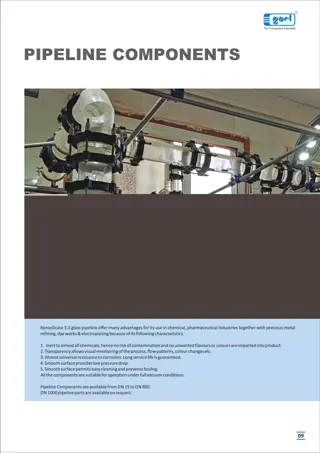Glass Forming in Manufacturing Process: Methods and Techniques
Glass forming is a crucial stage in the manufacturing process, essential for shaping molten glass into various products. Techniques such as blowing, rolling, stretching, and casting are employed based on the application. Different processes exist for pieceware, flat glass, and fiber-making, each with specific methods like spinning, pressing, and press-and-blow. Modern technologies have mechanized most glass-shaping processes, ensuring efficient production of items like jars, bottles, and light bulbs.
Download Presentation

Please find below an Image/Link to download the presentation.
The content on the website is provided AS IS for your information and personal use only. It may not be sold, licensed, or shared on other websites without obtaining consent from the author. Download presentation by click this link. If you encounter any issues during the download, it is possible that the publisher has removed the file from their server.
E N D
Presentation Transcript
GLASS LECTURE 6 Glass Forming By Asst. Lect. Shireen Hasan
Glass forming Glass forming is an intermediate stage in glass manufacturing process. It comes in between glass melting and annealing. Manufacturing of almost all commercial glass comprises of different stages. In forming stage of glass manufacturing, viscosity of molten glass changes gradually with temperature. Glass forming permits molten glass to be shaped into flat sheets and filaments by controlling the viscosity.
Depending upon the applications, there are different processes of forming the glass. The most common type of glass forming process can be categorized as: Blowing, rolling, stretching and casting. Methods for shaping glass are quite different from those used for traditional and new ceramics. So the Shaping processes to fabricate the glass products can be grouped into three categories: A- Discrete processes for piece ware (bottles, jars, plates, light bulbs). B- Continuous processes for making flat glass (sheet and plate glass) and tubing (laboratory ware fluorescent lights). C- Fiber-making processes to produce fibers (for insulation and fiber optics).
A- Shaping of Piece Ware Ancient methods of hand-working glass included glass blowing. Handicraft methods are still used today for making glassware items of high value in small quantities. However, most modern glass shaping processes are highly mechanized technologies for producing discrete pieces such as jars, bottles, and light bulbs in high quantities. A1- Spinning similar to centrifugal casting of metals A2- Pressing for mass production of flat products such as dishes, bake ware, and TV tube faceplates A3- Press-and-blow for production of wide-mouth containers such as jars A4- Blow-and-blow - for production of smaller-mouth containers such as beverage bottles and incandescent light bulbs A5- Casting for large items such as large astronomical lenses that must cool very slowly to avoid cracking
A1- Spinning Glass parts such as back sections of cathode ray tubes for TVs and computer monitors are manufacturing as following: (1) Gob of glass dropped into mold; and (2) Rotation of mold to cause spreading of molten glass on mold Surface.
A2- Pressing (1) Glass gob is fed into mold from furnace; (2) Pressing into shape by plunger; and (3) Plunger is retracted and finished product is removed symbols V and F indicate motion (velocity) and applied force.
A3- Press-and-blow (1) Molten gob is fed into mold cavity; (2) Pressing to form a parison; (3) The partially formed parison, held in a neck ring, is transferred to the blow mold , and (4) blown into final shape
A4- Blow-and-blow (1) Gob is fed into inverted mold cavity; (2) Mold is covered; (3) First blowing step; (4) Partially formed piece is reoriented and transferred to second blow mold, and (5) Blown to final shape.
A5- Casting If molten glass is sufficiently fluid, it can be poured into a mold Relatively massive objects, such as astronomical lenses and mirrors, are made by this method After cooling and solidifying, the piece must be finished by lapping and polishing Casting of glass is not often used except for special jobs Smaller lenses are usually made by pressing.
B- Shaping of Flat and Tubular Glass Processes for producing flat glass such as sheet and plate glass: B1- Rolling of flat plate B2- Float process Process for producing glass tubes: B3- Danner process
B1- Rolling of Flat Plate Starting glass from melting furnace is squeezed through opposing rolls whose gap determines sheet thickness followed by grinding and polishing for parallelism and smoothness
B2- Float Process Molten glass flows onto the surface of a molten tin where it spreads evenly across the surface, achieving a uniform thickness and smoothness - no grinding or polishing is needed bath ,
B3- Danner Process Molten glass flows around a rotating hollow mandrel through which air is blown while the glass is drawn
C- Forming of Glass Fibers Glass fiber products can be divided into two categories, with different production methods for each: 1. Fibrous glass for thermal insulation, acoustical insulation, and air filtration, in which the fibers are in a random, wool-like condition C1- Produced by centrifugal spraying 2. Long continuous filaments suitable for fiber reinforced plastics, yarns, fabrics, and fiber optics C2- Produced by drawing
C1- Centrifugal Spraying In a typical process for making glass wool, molten glass flows into a rotating bowl with many small orifices around its periphery Centrifugal force causes the glass to flow through the holes to become a fibrous mass suitable for thermal and acoustical insulation
C2- Drawing of Glass Continuous glass fibers of small diameter (lower limit is about 0.0025 mm) are produced by drawing (pulling) strands of molten glass through small orifices in a heated plate made of a platinum alloy




























